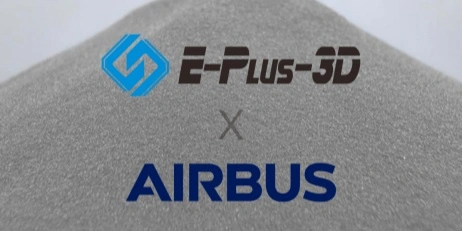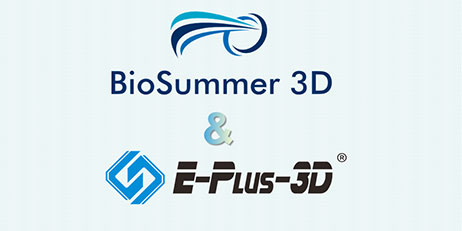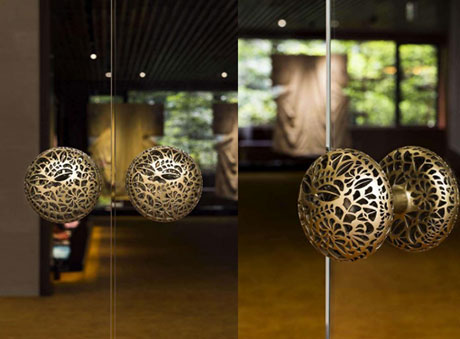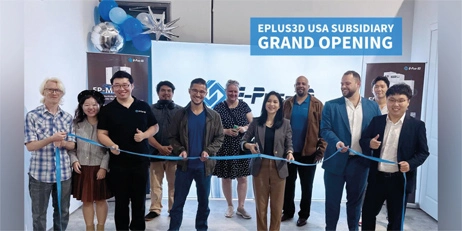1. Introduction
Eplus3D, a leading manufacturer of Metal powder Bed Fusion (MPBFTM) machines, has been engaged in research and development of AM systems and application technologies for over 30 years’ experience. With four facilities in Beijing, Hangzhou, Stuttgart and Houston, Eplus3D aims to strengthen and industrialize its additive manufacturing solutions globally.
Airbus Central Research & Technology (CRT), the corporate research department of Airbus, focuses on advancing technologies like materials science and additive manufacturing to support aerospace applications. Frank Palm, senior expert on metallic technologies at Airbus CRT, has extensive experience in advance materials and 3D printing, particularly with ScalmalloyⓇ. The AlMgSc material concept named with the brand ScalmalloyⓇ was developed about twenty years ago by Airbus CRT. The 3D printing related patent as well the protected brand is currently held by the Airbus subsidiary APWORKS GmbH, Taufkirchen, Germany.
The motivation of the partnership between Eplus3D and Airbus CRT aims to demonstrate the capabilities of the Eplus3D EP-M260 MPBF machine and optimize Scalmalloy'sⓇ use in metal powder bed fusion, advancing its application in lightweight aerospace components to improve performance and efficiency.
2. Materials and Methods
The ScalmalloyⓇ powder used for additive manufacturing in this study was provided by Airbus CRT. The strength of ScalmalloyⓇ comes from its unique composition, particularly the addition of scandium. Scandium forms fine nano-sized fully coherent precipitates of Al₃Sc that strengthen the alloy. The elemental composition of the powder is outlined in the following table.

Table 1: Chemical composition (determined by ICP-OES measurements).
The samples were produced using an Eplus3D EP-M260 with a build volume of 260 x 260 x 390 mm and 500W lasers. To control the heat input and process dynamics targeting a maximum built material density > 99.8% precise LPBF process parameter adjustments were necessary. The development of the scanning strategy and the printing of the test samples were carried out at Eplus3D´s German subsidiary. The build layout included both horizontally and vertically printed samples, ensuring that the mechanical properties could be evaluated across different orientations and positions in the build area. An extremely clean process environment (oxygen chamber content < 200 ppm) was achieved thanks to the Eplus3D´s unique preparation process using a hybrid purging process with the aid of a vacuum pump.
All printed samples underwent simple 1-step aging treatment at 325°C for 4 hours to relieve the process induced stresses and to optimize mechanical performance. Additionally, some samples were subjected to Hot Isostatic Pressing (HIP), carried out at 300°C for 4 hours under 2000 bar. The HIP process is helpful for further reducing (undesired) porosity and enhancing fatigue resistance by improving material density and eliminating internal defects. All samples were machined before testing in order to comply with the test body geometries defined in DIN EN ISO 6892-1:2020-06 (static testing) and DIN EN 6072:2011-06 (fatigue testing).
To evaluate the mechanical properties of the directly generated samples material, both static and fatigue tests were performed. The static tests using a Zwick Universal Tensile Tester, device record Yield Strength (YS), Ultimate Tensile Strength (UTS), elongation (Z), and reduction in area (A5 “fracture constriction”) for both horizontally and vertically manufactured samples. The high cycle fatigue testing was conducted only on vertically printed samples using a stress concentration factor of Kt = 1 (test body geometry FCE A12.5) and a frequency of 151 Hz (RUMUL resonance pulsing testing device). The load ratio R was set 0.1 to give a representative near real-life test condition that the part would experience during flight. The stress amplitudes were set to 300 and 340 MPa. Comparisons were made between aged and HIP-treated samples, in order to investigate the impact of HIP on fatigue performance.
In all cases, the dynamic test results of the recently printed Eplus3D samples were compared with those of an alternative MPBF manufacturing machine using the same ScalmalloyⓇ powder lot. All test results were provided by Airbus CRT.
3. Results of the Investigation
The following diagram (Figure 1) illustrates the static test results, highlighting key mechanical properties such as yield strength, ultimate tensile strength, and elongation as well fracture constriction. The assessment is based on 15 vertically and 15 horizontally built samples which revealed some particular propensities of the ScalmalloyⓇ material concept. Though the time gap between the powder production date and the actual investigation has been about 5 years, the strength and ductility properties deduced from the build trial are excellent. Powder feedstock aging or degradation seems to be neglectable if proper storage conditions are secured. As has already been outlined in previous ScalmalloyⓇ evaluations over the last 15 years there is fairly no strength anisotropy visible. Showcased in Figure 1 vertically as well horizontally built samples disclose about 570 MPa UTS with more than 10% fracture elongation. The precipitation hardening efficiency of the Al3Sc (Zr) coherent phase is really impressive, causing an increase in YS of more than 200 MPa after 325°C heat treatment. The UTS improvement reaches more than 150 MPa. HIP heat treatments executed in the same temperature range do not change the static properties but will have a more pronounced impact on ScalmalloyⓇ fatigue resistance. See results below:
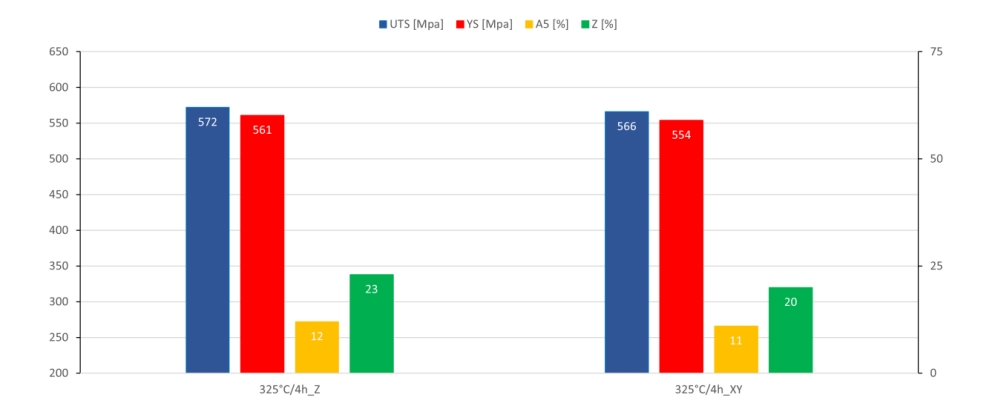
Figure 1: Static test results of the vertically and horizontally printed samples by Eplus3D. The left ordinate shows the UTS and YS. A5 and Z are indicated with the right ordinate.
The following diagram (Figure 2) presents the results of the high cycle fatigue tests conducted on Eplus3D vertically built samples with and without hipping (green and red dots) compared to fully hipped test samples of the previous investigation (all blue dots) using the same powder feedstock. All three non-hipped EP-M260 fatigue test bodies (green dots) were showing very consistent fatigue life at 300 MPa max. tensile stress with a lifetime window of around 30.000 loading cycles. Two of the hipped specimens tested at increased maximum stress of 340 MPa survived nearly 50.000 cycles. The one tested at 300 MPa failed beyond 2 x 106 cycles in the threaded clamping region of the test body (most likely this sample had been able to reach 3 x 107 cycle which is at Airbus CRT the final time limit during fatigue testing of Al-alloys). The difference or improvements respectively HIP can offer especially w.r.t. bulk material durability counts for a 50 - 100x lifetime enhancement at a given max. stress level of 300 MPa or vice versa a load increase possibility of about 15 - 20% keeping the same lifetime.
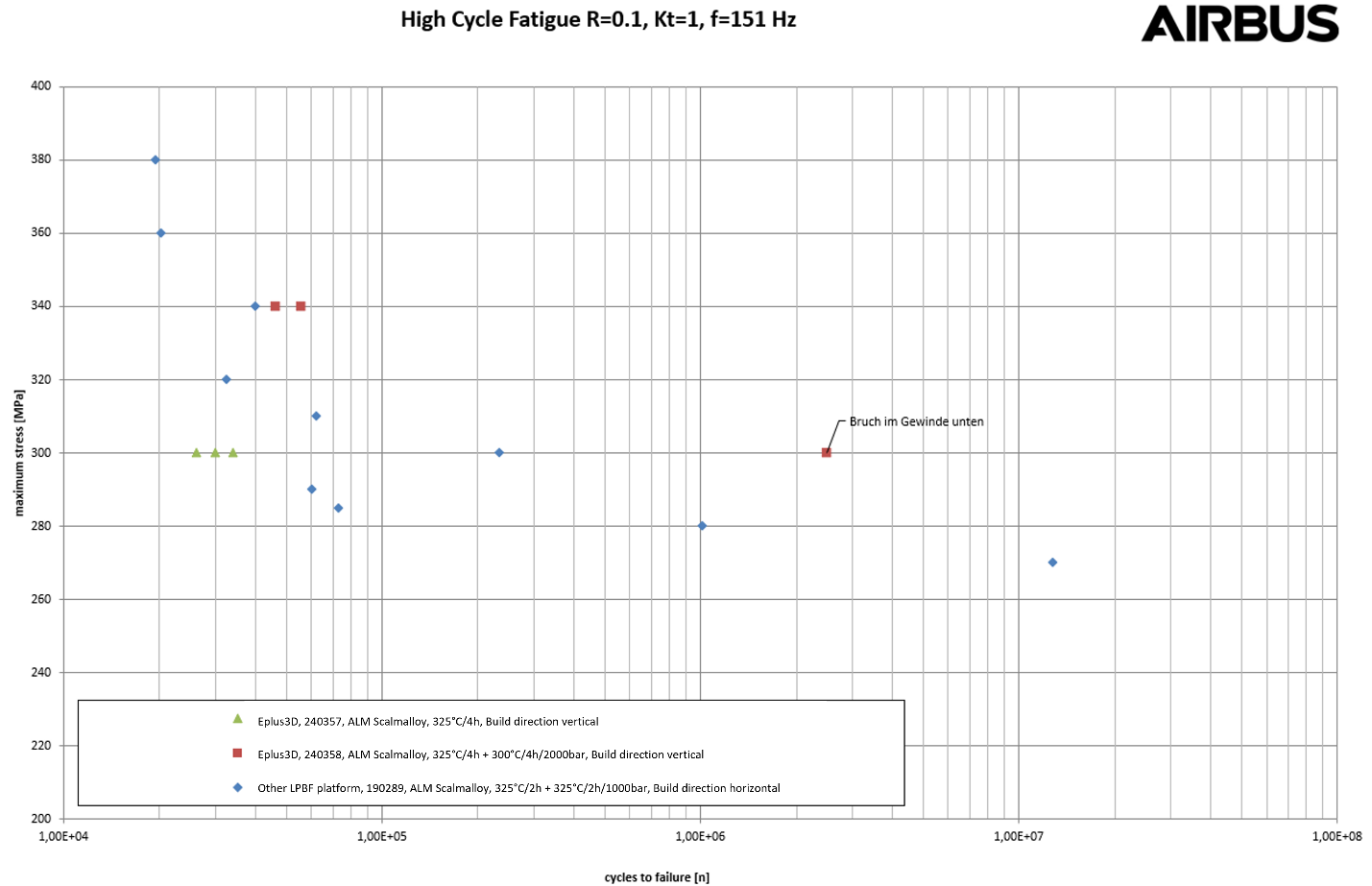
Figure 2: Fatigue test results of vertically printed samples by Eplus3D and horizontally printed samples by an alternative MPBF machine. The ordinate shows a maximum stress scale and the abscise shows the cycles to failure on a logarithmic scale.
It is worth mentioning that the current fatigue data was sourced from vertically built test bodies, which normally perform worse than horizontally built samples, again highlighting the high material quality created with the Eplus3D EP-M260 MPBF Machine.
4. Conclusion
In static tests, ScalmalloyⓇ samples printed both horizontally and vertically showed comparable and consistent strength values, proving the material’s ability to maintain performance across different orientations and positions on the build platform.
The fatigue investigations demonstrate that the fatigue values elaborated 5 years ago were repeated or even slightly exceeded in the recent trials using the Eplus3D metal AM machine EP-M260. Certainly, this is not statistically yet significant. More data would be necessary. But the trend is serious.
These encouraging results in both static and dynamic tests can be attributed to stable printing parameters, a clean printing environment and the adequate heat treatment, all of which are well suited to the ScalmalloyⓇ material concept. Achieving high part density is crucial to maximizing the performance of ScalmalloyⓇ, and the Eplus3D EP-M260 used in this study ensured a clean and controlled printing environment. A meticulous preparation is essential to produce high-density parts, which translates to improved mechanical properties, as demonstrated by the test results.
5. Future Development
The results from this initial phase of the study are promising, highlighting strong machine capability and process quality. As we celebrate this project milestone, further testing will validate these findings and enhance the consistency of the study. Moreover, conducting metallographic analysis of the samples used in this collaboration, along with fracture surface area analysis through Scanning Electron Microscopy (SEM), will yield valuable insights into microstructural integrity and failure mechanisms, facilitating future process optimizations.
Future development will also focus on refining the scanning parameters at the Eplus3D German subsidiary to optimize the printing process and maintain consistent high quality results. Increasing productivity by developing larger layer thicknesses will be a key objective, using the new EP-M400S, which features four 700W lasers and bidirectional recoating. The larger build volume of the EP-M400S will also enable the production of larger parts, expanding the potential applications for ScalmalloyⓇ in the aerospace industry.
